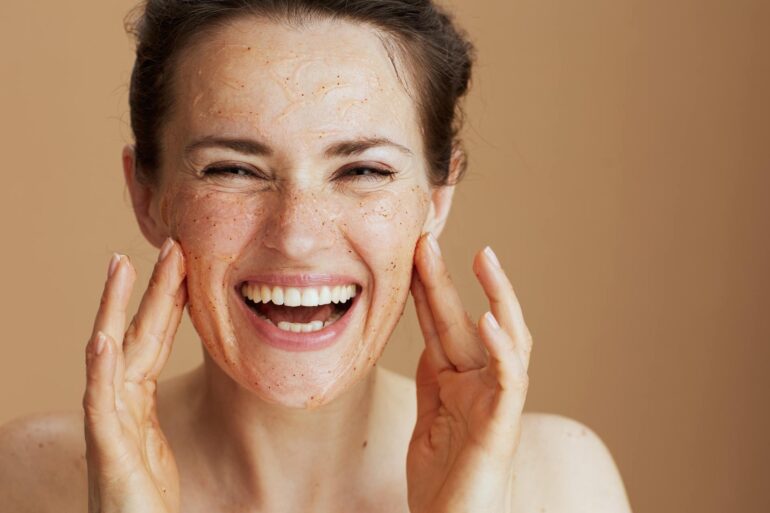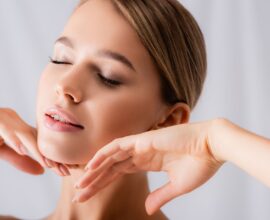The benefits of facial peeling: renew your skin for a brighter appearance
Discovering facial peeling: a treatment to transform your skin
Give your face brightness, even out complexion and reduce and minimize skin’s blemishes, redness and scars: there are just a few amazing benefits of peeling, a facial treatment to regenerate your skin, making it smooth, healthy and luminous.
Facial peeling is one of the most popular and recent aesthetic treatments, boasting great versatility. It is able to respond to multiple needs of facial skin, such as lightening acne scars, evening out complexion, reducing blemishes and redness, or smoothing wrinkles. Since the first application, results look clearly visible, making it one of the best treatments for those seeking healthier and brighter skin quickly and effectively.
It’s no coincidence that the popularity of facial peeling has grown both in professional and home-made skincare field, with an increasingly wide range of proper cosmetics available in perfumeries and professional stores. Indeed, a real must for those who always look for fresh, smooth and bright skin, possibly slowing down skin aging.
But what is facial peeling and how does it treat such a wide range of problems? Its principle of action is simple and effective: through chemical or mechanical agents, peeling removes skin’s dead cells that naturally accumulate on its surface (even in the deeper layers). As a matter of fact, to peel means “to exfoliate”. An action that stimulates cell renewal, a process that makes the epidermis “reborn” for an immediate smoother, even and luminous look.
Depending on the type of active agent, its ingredients and their concentration, the action of facial peeling can be modulated to adapt to different skin problems, such as acne, blemishes, wrinkles or sensitive skin, and of course to individual needs. For example, a superficial peel, performed with glycolic acid or mandelic acid, affects skin’s outer layers to give immediate “glow” effect without any particular side effects, while a “moderate” peel, performed with salicylic acid or lactic acid, penetrates deeper “attacking” target wrinkles and blemishes. Finally, a “deep” peel, such as phenol peel – which gained great popularity in recent months – is one of the most powerful chemical facial peels currently available.
However, it is important to underline that this type of peel, in addition to being particularly expensive (treatment rates can cost even thousand euros), it must be performed exclusively by qualified professionals in proper facilities. Acting in depth, in fact it involves greater risks and requires significantly longer recovery times, sometimes up to several weeks. Within this range of time, skin undergoes an intense cellular regeneration and thus needs specific care, including antibiotics soothing lotions to prevent infections and promote faster healing.
How does facial peeling work?
Despite the dynamic behind the effectiveness of facial peeling may look simple, it’s also true that not all peelings act the same way. Besides deep exfoliation, ranging from superficial to deeper beyond the epidermis, the exfoliating agents used by this treatment can be diverse, such as: chemicals, natural enzymes, microgranules gels or mechanical tools
Here are the three most popular kinds of facial peeling:
1. Chemical peeling
One of the most common types of peeling (maybe the most popular) which uses chemicals, such as glycolic, salicylic, mandelic or trichloroacetic acids, dissolving the bonds keeping together dead cells on skin’s surface, stimulating the production of collagen and promoting the regeneration of cells. Chemical facial peeling gives your skin a healthier, smoother and more radiant texture and appearance, making it particularly suitable for those who suffer from problems such as acne, dark spots (like hyper-pigmentation) or dyschromia, to reduce wrinkles and visible signs of aging. This type of treatment can be performed both at home, using delicate and low-concentration products, or in beauty centers by expert professionals, who can use more powerful acids with even faster and satisfying results.
2. Mechanical peeling
As the name suggests, mechanical peeling is based on a physical exfoliating action, using microgranules (natural, such as quartz sand, crushed olive kernels or sodium bicarbonate, or synthetic) or specific tools (like discs and brushes). These elements usually include emulsions or gels, enriched with nourishing oils like jojoba, which make the treatment more delicate and suitable for sensitive skin. Massaged into skin, mechanical peeling effectively removes dead cells, stimulates cell renewal and gives smoother and brighter appearance.
Mechanical peeling is particularly suitable for people looking for deep but delicate cleansing, while it can feel aggressive for who suffer from inflamed acne, deep scars or sensitive skin, because the abrasive action of microgranules and exfoliating tools could further irritate skin, aggravating redness and inflammation, thus compromising skin’s barrier due to sensitivity, dryness or allergic reactions.
3. Enzymatic peeling
Enzymatic peeling leverages the action of natural enzymes, based on fruits such as papaya and pineapple, to gently remove dead skin cells. Unlike chemical peeling, which acts through the use of acids, enzymes break down the proteins binding dead cells together, promoting cell renewal in a delicate and natural way, making it particularly suitable even for sensitive skin, prone to irritation or very reactive.
The three types of facial peeling – mechanical, chemical and enzymatic – are not necessarily alternatives each other, but can even be combined to provide more complete exfoliating action. Some formulations finely integrate microgranules for delicate mechanical exfoliation, exfoliating acids for a deeper chemical action and natural enzymes to stimulate cell turnover.
In addition to exfoliation, formulations can vary from the simplest and basic ones to those enriched with functional active ingredients, to enhance treatments effectiveness and adapt to specific skin needs. Some of the most common ingredients are vitamin C, phenomenal in illuminating skin and counteracting dyschromia and blemishes, hyaluronic acid to deeply hydrate skin, or peptides, to stimulate collagen production improving skin’s elasticity.
Furthermore, some peelings can be enriched with antioxidants such as green tea, to protect skin from environmental damage, or soothing plant extracts to reduce any post-treatment irritation, thus adapting to specific needs for different skin types.
If chosen carefully and applied correctly, respecting the frequency and methods of use, any type of facial peeling, whether chemical, mechanical or enzymatic, can significantly benefit your skin. Whether your goal is to achieve brighter skin, reduce blemishes or imperfections, or stimulate skin regeneration, facial peeling can give truly surprising results, as long as the facial treatment is performed properly and respecting your own skin.
The impressive benefits of facial peeling for your face skin
If performed correctly by respecting the needs of your skin, the benefits of facial peeling are truly numerous and sometimes impressive. Let’s check them out:
1. Improving skin’s texture
Peeling works by removing dead skin cells, which tend to accumulate on surface, making it duller, lifeless and dehydrated, thus accelerating cell turnover, essential to keep facial skin healthy, bright and fresh. Exfoliation of dead cells also prevents clogged pores, counteracting the formation of pimples, blackheads and other blemishes, particularly useful in the case of greasy or acne-prone skin. Another interesting effect refers to acne scars and aging lines, mainly caused by loss of elasticity, which tend to reduce at the first treatments. It happens because peeling stimulates the production of new, younger and fresher cells, which replace damaged ones. Over time, repeating the treatment guarantees even clearer results: the skin becomes progressively smoother, firmer and more even.
2. Reducing enlarged pores and imperfections
By removing dead cells and freeing pores from impurities and clogs, the treatment helps to smooth skin’s texture, making it visibly finer and more even. In addition, peeling’s mattifying effect hinders excessive shine, giving skin a balanced appearance, free of imperfections.
3. Enhancing skin’s tone and brightness
Peeling helps remove surface impurities and stimulates blood circulation, which improves oxygen and nutrients supply to the skin. This process activates cell regeneration, giving skin a visibly brighter, more even appearance. An immediate “glowy” effect that continues to intensify even after the treatment day after day. This progressive improvement makes the skin younger and healthier, creating a perfect base for any type of make-up.
4. Reducing skin’s blemishes
Peeling, whether chemical or mechanical, is particularly effective in treating discoloration and blemishes, such as those related to hyper-pigmentation or sunlight. By acting on the most superficial levels of skin, the treatment accelerates cell turnover, with the removal of damaged cells and the development of new ones. This helps to even out skin tone and reduce existing blemishes, even the most persistent. In addition, chemical peeling with the addition of specific acids, such as glycolic and mandelic acids, or maybe mechanical peeling by microgranules, works both on skin’s surface and deep layers, improving its texture and promoting the absorption of active ingredients to contrast hyper-pigmentation.
5. Stimulating collagen for a younger and firmer skin
Some types of peelings, especially chemical ones, stimulate collagen production, key protein that keeps skin elastic and firm. This process prevents and delays the appearance of the first signs of aging, such as wrinkles and skin laxity, and reduces the existing ones. The result is a wonderful natural lifting effect, with no need for scalpels or potentially risky invasive actions.
This is especially beneficial for mature skin, which over time tends to produce less collagen and elastin. Glycolic acid, for example, promotes the production of new collagen fibers, that improves skin’s elasticity and firmness.
6. Regenerating action
Facial peeling eliminates dead cells and stimulates cell turnover, promoting the regeneration of new, younger, fresher and more vital cells. This process of continuous renewal is key to keep your skin healthy, preventing the deterioration of its natural functions. In addition, peeling improves facial skin’s resistance to external agents, such as pollutants, UV rays and dust, some of the main causes of the production of free radicals.
These, related to the process of cellular oxidation, are responsible for skin aging, as they damage cellular structures and accelerate the onset of wrinkles and loss of elasticity. Some peelings are enriched with antioxidants, like vitamin C and green tea, to provide additional protection from external pollutants.
Many peelings also contain moisturizing and soothing ingredients to restore skin’s natural barrier and hydration. Hyaluronic acid, for example, is usually part of cosmetic formulas due to its ability to retain moisture, providing deep hydration thus making your skin softer and brighter. Hydration also enables skin to recover faster, reducing post-treatment discomfort. Moreover, soothing natural extracts like aloe vera or chamomile can be used to reduce redness, irritation or burning sensations, that may occur after the treatment.
Facial peeling: who’s suitable for (and who should avoid it)
Facial peeling is an exfoliating treatment that brings many benefits to the skin, but this does not mean that’s suitable for everyone. Each skin type has specific needs, and therefore some conditions may not be compatible with certain forms of peeling. So, it is essential to carefully evaluate the state of your skin and choose the most suitable treatment, preferably with the support of a dermatologist or an expert in aesthetic dermatology. Here are some general information about who can benefit from peeling and who, instead, should avoid it.
- Skin with imperfections, acne or scars: peeling is excellent to reduce skin problems such as acne, acne scars, enlarged pores and uneven texture. It can help to even out tone and improve firmness.
- Dull skin: when skin looks dull, peeling stimulates blood circulation and accelerates cell turnover, giving a fresher and brighter appearance.
- Skin with signs of aging: peeling stimulates collagen production, improving skin’s elasticity and combating aging, such as blemishes, wrinkles and sagging skin.
- Skin with hyper-pigmentation: a chemical facial peeling can even out skin’s tone, reduce blemishes and sunlight damage by stimulating cell regeneration and speeding up the removal of dead cells.
- Oily and pimple-prone skin: chemical peels, especially those containing salicylic acid, are particularly effective at reducing excess sebum and preventing the formation of pimples and blackheads.
Some skin conditions require special attention, as peeling may worsen certain phenomena or cause side effects. Here are a few cases in which facial peeling is not recommended.
- Very sensitive or irritated skin: peeling should be avoided if you have particularly sensitive and redness-prone skin, especially if you suffer from dermatitis, rosacea or other inflammatory conditions.
- Skin with sunburn: if your skin is sunburned or damaged by sunlight, peeling could further worsen dryness and flaking.
- Skin with infections or wounds: facial peeling should be avoided if you have active infections, wounds, sores or inflamed pimples, as it could aggravate inflammation or cause further irritation. It’s advisable to wait until skin has completely healed before undergoing the treatment.
- Pregnant or breastfeeding women: some chemical peelings, such as those based on glycolic or trichloroacetic acids, are not recommended in pregnancy or breastfeeding, as hormonal changes can make skin more sensitive and reactive. This could be risky also to the health of mother’s and baby’s skin, because acids can be absorbed into blood. Although not all of them are harmful, it is preferable to avoid potential risks and postpone the treatment.
- Use of other exfoliating treatments or sensitizing drugs: this can interfere with the peeling. Cosmetic treatments based on retinol, alpha-hydroxy acids (AHA), beta-hydroxy acids (BHA), benzoyl peroxide, or other drugs containing isotretinoin or cortisone, that increase skin’s sensitivity, could compromise the health of the skin barrier, potentially causing irritation, dryness and inflammation. It’s best to avoid the simultaneous use of these treatments and consult professionals to evaluate the compatibility of some cosmetic or pharmacological treatment with the peeling.
How to maximize the benefits of facial peeling with five simple tips
To maximize the effectiveness of facial peeling, it is essential to follow some precautions, like the choice of the best treatment for your needs and skin type, the meticulous respect for application times and correct post-treatment skin barrier, which includes the application of hydrating creams and serums and a sunscreen. Furthermore, evaluating the possibility of undergoing professional treatments can be the solution for visible and long-lasting results.
Here are five good practices to maximize the benefits of peeling, and at the same time minimize potential side effects, keeping your skin healthy, bright and regenerated for longer.
1. A gradual beginning
Those who are new to peeling should go for gentle treatments, such as those based on mandelic or lactic acids, with low concentrations of active ingredients. These lighter peels allow to test skin’s reaction without risks of irritation. As first treatment, it’s recommended to apply the product just for a while, up to 3-5 minutes, to assess skin’s tolerance. Only after checking your skin’s reaction and verifying the absence of irritation or reactions, you can gradually increase the application time (up to 10-15 minutes) and consider the use of peels with more intense properties, such as glycolic or salicylic acids, depending on your skin’s specific needs. This progressive approach ensures skin to avoid excessive stress and slowly adapt to stronger treatments, improving peeling results without damaging your skin barrier.
2. Find the best treatment for your skin type
Every skin has specific needs, and choosing the right peeling is key to achieve great results without damage. For example, sensitive skin can benefit from gentle peels, such as those based on mandelic or lactic acids, to gently exfoliate skin without irritating. People with oily or acne-prone skin should instead opt for peels based on salicylic or glycolic acids, that help regulate sebum production and purify pores.
Mature skin, on the other hand, can find a valid ally in treatments with high-concentration of glycolic acid, which intensively stimulates cell turnover and improves skin elasticity and tone. Those willing to hinder blemishes or dyschromia can opt for facial peelings with tranexamic or kojic acids, especially suitable to even out skin’s tone and lightening blemishes or scars.
3. Respect ideal treatment regularity depending on the type of peeling
Although it’s a highly effective treatment, is essential to comply peeling’s regularity to avoid over-stressing your skin and compromising the natural balance of skin barrier. While lighter peelings can be repeated even 2-3 times per week, more intense chemical peelings should be performed once every 3-4 weeks, according to the specific needs of your skin and the response to the treatment.
4. Adopt a proper post-treatment care
After facial peeling, your skin requires special care. It is helpful to apply serums or creams based on hydrating and soothing ingredients, such as hyaluronic acid and ceramides, to promote skin barrier’s regeneration, prevent irritation, dryness and redness and accelerate cell regeneration, maximizing peeling’s benefits. It’s also important to use a broad-spectrum sunscreen daily, with SPF 30 or higher, to prevent the risk of hyper-pigmentation and other damage caused by UV rays, considering the increased sensitivity of skin after the treatment.
5. Consider professional treatments
To achieve even more visible and long-lasting results, it’s best to rely on exfoliating treatment performed by professional qualified experts, such as dermatologists, beauticians or aesthetic doctors with advanced experience and certification in dermatology or aesthetic medicine. These treatments leverage highly concentrated acids and advanced techniques to penetrate deeper in skin than basic peelings, addressing complex problems such as wrinkles, dyschromia, sunlight blemishes and acne scars.
A national and international point of reference for medical-aesthetic treatments, including effective facial peelings, is certainly Acquaforte Thalasso & Spa at Forte Village, the “most beautiful resort in the world” located near the most beautiful beaches in Sardinia in the enchanting town of Santa Margherita di Pula, just forty-five minutes by car from Cagliari.
Healthy and bright facial skin with the treatment Peeling Prx-t33 by Acquaforte Thalasso & Spa at Forte Village
Regenerating skin in a delicate non-invasive way, giving an immediate, incredible brightness, is now possible at the exclusive Acquaforte Thalasso & Spa at Forte Village, a true heaven on earth within over 50 hectares of greenery, characterized by an incredible biodiversity, which surround this prestigious resort in Santa Margherita di Pula. A peaceful oasis of well-being designed for those who want to take care of their wellness and beauty holistically, inside and outside, through a wide range of paths including thalassotherapy and personal treatments in collaboration with Deasalus, a true authority in Italy (and beyond) in aesthetic medicine.
One of these is the highly effective Peeling Prx-t33 bio-revitalizing peeling, a completely safe and painless treatment combining the regenerating power of 33% trichloroacetic acid (TCA), in addition to 5% kojic acid, a lightening and depigmenting agent whose function is to inhibit post-inflammatory pigmentation, and hydrogen peroxide, or more simply oxygenated water, at low concentration, which promotes wound repair, modulates inflammation and intervenes in the remodeling of the extracellular matrix.
A mix of active ingredients to stimulate deep regeneration and eliminate impurities on the dermis, leaving skin significantly more hydrated, firm and luminous, but also even out the complexion and reduce wrinkles and signs of aging, scars, including acne’s, and sunshine blemishes.
Furthermore, unlike other regenerating treatments, Prx-t33 Peeling does not require any recovery time (you can immediately return to your activities after treatment), it is not photosensitizing and can be repeated even weekly to stimulate the synthesis of collagen. The hydrogen peroxide reduces the aggressiveness of TCA, making the treatment suitable even for sensitive skin without causing significant irritation or visible flaking, as it affects the dermis without exfoliating epidermis, with appreciable results since the first session already.
It can also be performed in combination with other aesthetic medicine treatments by the Forte Village Spa, to even enhance their effectiveness. Like Sofwave, a treatment that uses the synergy of ultrasound and heat to smooth out wrinkles while improving skin tone, the Natural Biolifting Viso by Dr. Joanna Hakimova, an innovative technique that “sculpts” facial features by stimulating natural cellular rejuvenation, and Signature Oxygen Facial Therapy Massage, which combines the benefits of oxygen with the excellence of Sardinian materials, giving skin a natural lifting effect and extraordinary luminosity.
Incredible results can also be achieved from the combination of chemical facial peelings, the botox-effect face mask with vitamin C, soothing, decongestant, hydrating and illuminating, and Viso Pure+, a non-invasive treatment which regenerates skin through the action of radio frequency to smooth and flatten wrinkles and improve facial luminosity.
For further information about facial peeling and other treatments by the Spa, or for booking a stay at Forte Village Resort, please call +390709218818 or email holiday@fortevillage.com.
Do you want to spend a dream vacation in a true paradise and discover the most effective treatments for facial skin? Book your stay at Forte Village Resort in Sardinia






